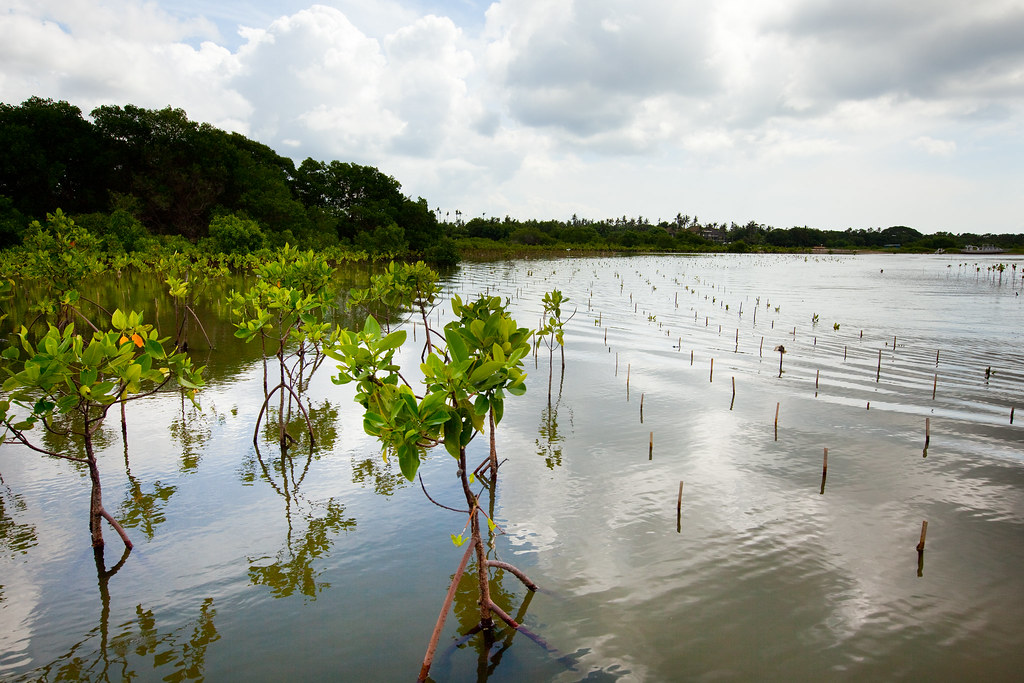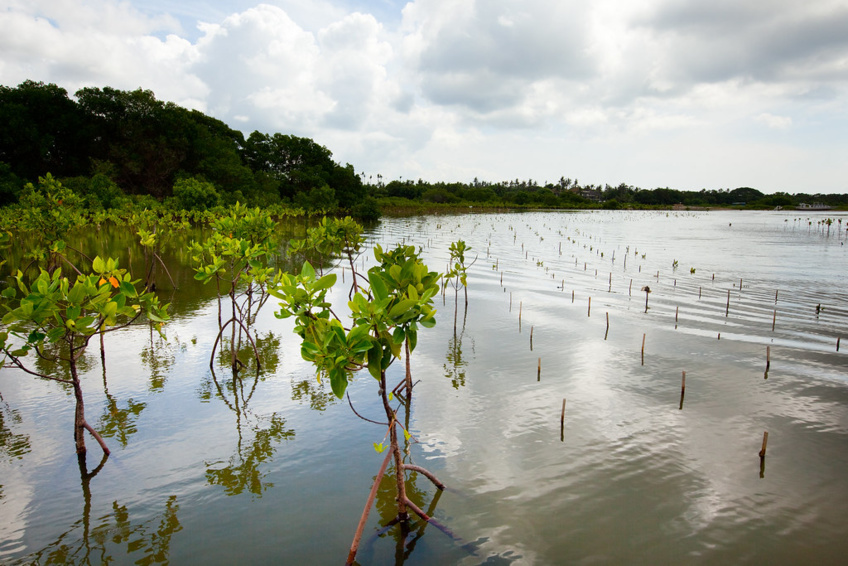We had been kayaking along the southern shore of the Arabian Gulf for approximately 30 minutes when M. Sanjayan, the CEO of Conservation International, silenced our conversation with a single word. "Listen," he instructed.
Initially, there was nothing but the gentle lapping of water against our kayaks and the distant flapping of wings. Then, the surroundings filled with sounds—nature's symphony.
Thirty-five of us had journeyed an hour and a half north from the artificially cooled conference rooms and bustling reception halls of Dubai, United Arab Emirates, where we had spent the previous week at the UN Climate Change Conference, also known as COP28. Alongside government officials, nonprofit representatives, and private-sector leaders, we were dedicated to advancing solutions for the climate crisis. However, today was an opportunity to breathe life into those discussions and reconnect with the essence of our shared mission.
In 2020, Mastercard, in collaboration with Conservation International and World Resources Institute, initiated the Priceless Planet Coalition. This coalition united businesses and consumers in the fight against climate change, aiming to restore 100 million trees across six continents.
Our approach involves working closely with scientific experts to design and identify projects, ensuring the integrity of our restoration practices. Collaboration with communities facing threats to their lives and livelihoods due to habitat loss is also central to our efforts. Notable examples include the Indigenous Arhuaco of the Colombian highlands, the fishing communities of Cambodia's Tonle Sap lake, and the farmers of Australia's Southern Tablelands.
In the Middle East, our focus turned to 25 acres of mangrove forest in the UAE. Partnering with Emirates Nature-World Wildlife Fund, we set out to restore 50,000 mangrove trees along the Arabian Gulf. Beyond capturing carbon, these mangroves act as natural barriers against storm surges, provide habitats for diverse marine species, and support the health of local fisheries, contributing to the overall regional economy.
COP28 provided a unique moment for our customers and partners to comprehend the exceptional nature of the Priceless Planet Coalition, setting it apart from other planting and restoration initiatives. On this day, they immersed themselves in a crucial ecosystem, actively contributing to its future by planting mangrove saplings. Our goal was to inspire them to initiate their own campaigns, aligning with the coalition's objective of restoring 100 million trees.
That morning, accompanied by Sanjayan, Johan Rockström of the Potsdam Institute for Climate Impact Research, Conservation International's chief scientist, and other globally recognized conservation and climate experts, we embarked on a journey. Upon reaching Mangrove Beach in Umm Al Quwain, we delved into the distinctive role played by coastal and marine systems in combating climate change.
Mangrove forests thrive in the saline coastal waters of the tropics and subtropics, boasting dense masses of roots both above and below the waterline that efficiently store "coastal blue carbon," a term denoting carbon captured in saltwater ecosystems. (Sea grasses and salt marshes fulfill a similar role.)
While these ecosystems globally occupy less space than tropical rainforests, they can sequester more carbon per acre at a faster rate. This makes them an indispensable and irreplaceable tool in our battle against climate change, with Sanjayan aptly labeling mangrove forests as "the hardest-working habitats on earth."
Navigating our kayaks under the intense sun, we observed the intricacies of our surroundings—the subtle ripples on the calm water, the black-tipped wings of flying flamingos, and the slender stalks of mangrove saplings piercing the water's surface. Our time on the water provided further insights from experts, but, as Sanjayan suggested, we also allowed the beauty and tranquility of the landscape to convey its own message. It's audible; one just needs to be open to listening.
As the tide retreated, we approached the shore, anticipating the main event. Carrying foot-tall saplings, we strolled along the beach to the planting site, wiping the dirt from the mangroves' root balls and carefully placing them into the muddy soil. Covered in silvery gray silt, our hands and knees, pink-necked from the heat, and shoulders tight and sore, our spirits remained high.
While everyone at COP28 acknowledged the critical nature of the moment, our visit to Mangrove Beach underscored the potential of our mission. It breathed life into the possibilities of high-quality, science-based restoration, sparking candid discussions with our customers and coalition partners about our objectives, shared strategies, and how, by weaving together our networks, we could achieve a more profound impact.
Now, with our feet firmly planted in the mud, establishing roots in the soil, a new bloom emerged—our connections to the natural world, to each other, and to our mission to combat climate change, one mangrove at a time.
Initially, there was nothing but the gentle lapping of water against our kayaks and the distant flapping of wings. Then, the surroundings filled with sounds—nature's symphony.
Thirty-five of us had journeyed an hour and a half north from the artificially cooled conference rooms and bustling reception halls of Dubai, United Arab Emirates, where we had spent the previous week at the UN Climate Change Conference, also known as COP28. Alongside government officials, nonprofit representatives, and private-sector leaders, we were dedicated to advancing solutions for the climate crisis. However, today was an opportunity to breathe life into those discussions and reconnect with the essence of our shared mission.
In 2020, Mastercard, in collaboration with Conservation International and World Resources Institute, initiated the Priceless Planet Coalition. This coalition united businesses and consumers in the fight against climate change, aiming to restore 100 million trees across six continents.
Our approach involves working closely with scientific experts to design and identify projects, ensuring the integrity of our restoration practices. Collaboration with communities facing threats to their lives and livelihoods due to habitat loss is also central to our efforts. Notable examples include the Indigenous Arhuaco of the Colombian highlands, the fishing communities of Cambodia's Tonle Sap lake, and the farmers of Australia's Southern Tablelands.
In the Middle East, our focus turned to 25 acres of mangrove forest in the UAE. Partnering with Emirates Nature-World Wildlife Fund, we set out to restore 50,000 mangrove trees along the Arabian Gulf. Beyond capturing carbon, these mangroves act as natural barriers against storm surges, provide habitats for diverse marine species, and support the health of local fisheries, contributing to the overall regional economy.
COP28 provided a unique moment for our customers and partners to comprehend the exceptional nature of the Priceless Planet Coalition, setting it apart from other planting and restoration initiatives. On this day, they immersed themselves in a crucial ecosystem, actively contributing to its future by planting mangrove saplings. Our goal was to inspire them to initiate their own campaigns, aligning with the coalition's objective of restoring 100 million trees.
That morning, accompanied by Sanjayan, Johan Rockström of the Potsdam Institute for Climate Impact Research, Conservation International's chief scientist, and other globally recognized conservation and climate experts, we embarked on a journey. Upon reaching Mangrove Beach in Umm Al Quwain, we delved into the distinctive role played by coastal and marine systems in combating climate change.
Mangrove forests thrive in the saline coastal waters of the tropics and subtropics, boasting dense masses of roots both above and below the waterline that efficiently store "coastal blue carbon," a term denoting carbon captured in saltwater ecosystems. (Sea grasses and salt marshes fulfill a similar role.)
While these ecosystems globally occupy less space than tropical rainforests, they can sequester more carbon per acre at a faster rate. This makes them an indispensable and irreplaceable tool in our battle against climate change, with Sanjayan aptly labeling mangrove forests as "the hardest-working habitats on earth."
Navigating our kayaks under the intense sun, we observed the intricacies of our surroundings—the subtle ripples on the calm water, the black-tipped wings of flying flamingos, and the slender stalks of mangrove saplings piercing the water's surface. Our time on the water provided further insights from experts, but, as Sanjayan suggested, we also allowed the beauty and tranquility of the landscape to convey its own message. It's audible; one just needs to be open to listening.
As the tide retreated, we approached the shore, anticipating the main event. Carrying foot-tall saplings, we strolled along the beach to the planting site, wiping the dirt from the mangroves' root balls and carefully placing them into the muddy soil. Covered in silvery gray silt, our hands and knees, pink-necked from the heat, and shoulders tight and sore, our spirits remained high.
While everyone at COP28 acknowledged the critical nature of the moment, our visit to Mangrove Beach underscored the potential of our mission. It breathed life into the possibilities of high-quality, science-based restoration, sparking candid discussions with our customers and coalition partners about our objectives, shared strategies, and how, by weaving together our networks, we could achieve a more profound impact.
Now, with our feet firmly planted in the mud, establishing roots in the soil, a new bloom emerged—our connections to the natural world, to each other, and to our mission to combat climate change, one mangrove at a time.


 Transformative Mangrove Restoration: Unveiling Nature's Climate Change Defense with Global Experts
Transformative Mangrove Restoration: Unveiling Nature's Climate Change Defense with Global Experts





 Companies
Companies